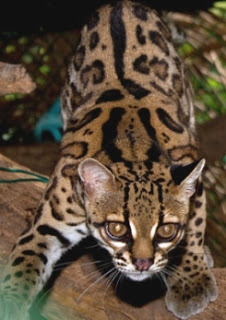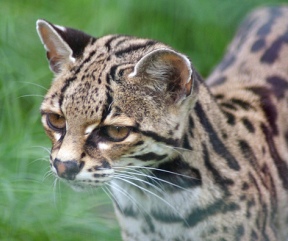Dogs
 By Langley Cornwell
By Langley Cornwell
Often mistaken for the Ocelot, the Margay is a smaller breed of wild cat that shares the same territory. In fact, the Margay is also known as a tree Ocelot. There are many differences between the two breeds, however. Sadly, these differences have led the Margay breed to become endangered, which is why it's so important to learn about this fascinating cat. Below, you'll find information about the Margay's habitat, some unique facts about this rare breed, and the reason that this special wild cat is endangered.
Description
The Margay has a beautiful black-spotted golden brown coat along with a white chest. Their spots usually feature a lighter colored center and appear to have a darker ring around the edge. The Margays are one of the smallest wild cats; fully grown, they measure 17-25 inches and weigh between four and nine pounds. In the wild, Margays can live up to 10 years, but do much better in captivity with lifespans reaching 20 years. Their diet in the wild consists of reptiles, birds and small mammals. Sexually mature at the age of one year, gestation for the Margay lasts around 3 months and results in a small litter of one or two offspring.
Habitat
While the Margay shares the same habitat as the Ocelot, the breed stays in the forest and prefers to lounge in the trees. During the day, Margays rest in caves or other dark areas. At night they spend their time jumping from branch to branch and tree to tree, hunting for their evening meal. Margays are independent cats; they prefer to live alone and usually stake out their territory by marking their scent. This may be done with urine, feces or scent glands. The Margay breed has scent glands located between their toes, and males have more scent glands than females. While territories may overlap, the Margay maintains a solitary lifestyle.
Fascinating Facts
What truly makes the Margay wild cat unique is its ability to rotate its ankles 180 degrees. This is something that no other breed of cat can do. This rotating ability allows the cat to jump through the trees and hang on to branches with advanced efficiency. This distinctive characteristic also allows them to climb down a tree head first. Another interesting fact is that Margays do not stalk their prey. Instead, they lay hidden and pounce when the prey comes close.
Endangerment
 Unfortunately, due to deforestation, the Margay breed has become endangered. Because the breed prefers to stay in the forest, their numbers are dwindling. Another problem lies in the fact that the breed has been hunted for its gorgeous pelt. Conservationist programs are working to protect the forests these beautiful cats live in so that the breed can repopulate. At this time, however, the Margay breed is listed as “vulnerable” with their populations on a rapid decline.
Unfortunately, due to deforestation, the Margay breed has become endangered. Because the breed prefers to stay in the forest, their numbers are dwindling. Another problem lies in the fact that the breed has been hunted for its gorgeous pelt. Conservationist programs are working to protect the forests these beautiful cats live in so that the breed can repopulate. At this time, however, the Margay breed is listed as “vulnerable” with their populations on a rapid decline.
It's plain to see that the Margay is a beautiful breed of wild cat that has very unique talents. One can only hope that conservationists are able to save the breed from extinction.
Top photo by Brian Gratwicke
Bottom photo by Spencer Wright
Read more articles by Langley Cornwell
- ‘conservation Dogs’ Help To Save An Endangered Species
By Linda Cole Dogs have been bred for centuries to do specific jobs. Some breeds have a variety of jobs they excel at. The Anatolian Shepherd was bred to do one thing and do it well – guard his flock. Because of his dedication, bravery and size, this...
- Ocicats May Look Wild, But They’re Tame At Heart
By Julia Williams I vividly recall the first time I saw an Ocicat many years ago. I was at a cat show, and we were making the rounds looking at all of the different breeds. I stared at this exquisite spotted cat, certain that it wasn’t a domestic breed...
- The 26 Most Beautiful And Prolific Cat Breeds In The World
There are many breeds of domestic cat in the world and there are several millions of cat pets from around the world. However, the cat breeds listed below are the prettiest and the most popular as well. 1.) Main Coon Image Source Undeniably, the longhaired...
- Endangered Unique Species Of Asses And Donkeys
Some species of Asses and Donkeys have long been domesticated and had been of great importance to humans in many parts of the globe. These animals are significant in transportation and in agriculture. But due to human activities, their populations drastically...
- Sun Bear Facts And Information
The Sun Bear is the smallest of the bear family and lives in the forest of Southeast Asia. They only weigh 150 pounds in the Wild. Sun Bears are a mammal species and they can live up to 25 years in the wild. They are only 4-5 feet long and weigh 60-150...
Dogs
The Margay, a Rare Wild Cat Breed

Often mistaken for the Ocelot, the Margay is a smaller breed of wild cat that shares the same territory. In fact, the Margay is also known as a tree Ocelot. There are many differences between the two breeds, however. Sadly, these differences have led the Margay breed to become endangered, which is why it's so important to learn about this fascinating cat. Below, you'll find information about the Margay's habitat, some unique facts about this rare breed, and the reason that this special wild cat is endangered.
Description
The Margay has a beautiful black-spotted golden brown coat along with a white chest. Their spots usually feature a lighter colored center and appear to have a darker ring around the edge. The Margays are one of the smallest wild cats; fully grown, they measure 17-25 inches and weigh between four and nine pounds. In the wild, Margays can live up to 10 years, but do much better in captivity with lifespans reaching 20 years. Their diet in the wild consists of reptiles, birds and small mammals. Sexually mature at the age of one year, gestation for the Margay lasts around 3 months and results in a small litter of one or two offspring.
Habitat
While the Margay shares the same habitat as the Ocelot, the breed stays in the forest and prefers to lounge in the trees. During the day, Margays rest in caves or other dark areas. At night they spend their time jumping from branch to branch and tree to tree, hunting for their evening meal. Margays are independent cats; they prefer to live alone and usually stake out their territory by marking their scent. This may be done with urine, feces or scent glands. The Margay breed has scent glands located between their toes, and males have more scent glands than females. While territories may overlap, the Margay maintains a solitary lifestyle.
Fascinating Facts
What truly makes the Margay wild cat unique is its ability to rotate its ankles 180 degrees. This is something that no other breed of cat can do. This rotating ability allows the cat to jump through the trees and hang on to branches with advanced efficiency. This distinctive characteristic also allows them to climb down a tree head first. Another interesting fact is that Margays do not stalk their prey. Instead, they lay hidden and pounce when the prey comes close.
Endangerment
 Unfortunately, due to deforestation, the Margay breed has become endangered. Because the breed prefers to stay in the forest, their numbers are dwindling. Another problem lies in the fact that the breed has been hunted for its gorgeous pelt. Conservationist programs are working to protect the forests these beautiful cats live in so that the breed can repopulate. At this time, however, the Margay breed is listed as “vulnerable” with their populations on a rapid decline.
Unfortunately, due to deforestation, the Margay breed has become endangered. Because the breed prefers to stay in the forest, their numbers are dwindling. Another problem lies in the fact that the breed has been hunted for its gorgeous pelt. Conservationist programs are working to protect the forests these beautiful cats live in so that the breed can repopulate. At this time, however, the Margay breed is listed as “vulnerable” with their populations on a rapid decline.It's plain to see that the Margay is a beautiful breed of wild cat that has very unique talents. One can only hope that conservationists are able to save the breed from extinction.
Top photo by Brian Gratwicke
Bottom photo by Spencer Wright
Read more articles by Langley Cornwell
- ‘conservation Dogs’ Help To Save An Endangered Species
By Linda Cole Dogs have been bred for centuries to do specific jobs. Some breeds have a variety of jobs they excel at. The Anatolian Shepherd was bred to do one thing and do it well – guard his flock. Because of his dedication, bravery and size, this...
- Ocicats May Look Wild, But They’re Tame At Heart
By Julia Williams I vividly recall the first time I saw an Ocicat many years ago. I was at a cat show, and we were making the rounds looking at all of the different breeds. I stared at this exquisite spotted cat, certain that it wasn’t a domestic breed...
- The 26 Most Beautiful And Prolific Cat Breeds In The World
There are many breeds of domestic cat in the world and there are several millions of cat pets from around the world. However, the cat breeds listed below are the prettiest and the most popular as well. 1.) Main Coon Image Source Undeniably, the longhaired...
- Endangered Unique Species Of Asses And Donkeys
Some species of Asses and Donkeys have long been domesticated and had been of great importance to humans in many parts of the globe. These animals are significant in transportation and in agriculture. But due to human activities, their populations drastically...
- Sun Bear Facts And Information
The Sun Bear is the smallest of the bear family and lives in the forest of Southeast Asia. They only weigh 150 pounds in the Wild. Sun Bears are a mammal species and they can live up to 25 years in the wild. They are only 4-5 feet long and weigh 60-150...
